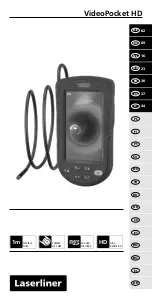
10
A-96.250.871 / 120417
AMI CACE
Product Description
Temperature
compensation
The mobility of ions in water increases with higher temperature,
which enlarges the conductivity. Therefore, the temperature is mea-
sured simultaneously by an integrated Pt1000 temperature sensor
and the conductivity is compensated to 25 °C. Several temperature
compensation curves designed for different water compositions can
be chosen. After cation exchanger (cation conductivity), the tem-
perature compensation curve strong acids has to be set.
For more information see:
Influence of Temperature on Electrical
Conductivity, PPChem (2012).
Standard
Temperature
The displayed conductivity value is compensated to 25°C standard
temperature.
Correction or
calibration
Not necessary.
Auto zero is done automatically each day at 0:30 at night.
Fluidics
The sample flows into the flow cell block [D] via the sample inlet [L].
With the first conductivity sensor [A] the specific conductivity of the
sample is measured. A capillary tube [F] placed after the first con-
ductivity sensor regulates the sample flow. Then the sample is led
through the sample chamber [I] containing a cation exchange resin.
Afterwards the cation conductivity of the sample is measured with
the second conductivity sensor [B]. The temperature is measured
with the temperature sensors integrated in the conductivity sen-
sors.
After the measurement of specific and cation conductivity, the sam-
ple leaves the measuring cell via flow meter [E] and flows through
the anode chamber, where protons are generated by electrolysis of
water:
H
2
O --> ½ O
2
+ 2 H
+
+ 2e
-
The water is then led through the cathode chamber where it is re-
duced according to:
2 H
+
+ 2 e
-
--> H
2
resp. 2 H
2
O + 2 e
-
--> ½ H
2
+ 2 OH
-
Finally, the sample leaves the EDI module and flows into the waste.
Regeneration
of the cation
exchange resin
Under the influence of the electrical field generated by the two
electrodes, the protons produced at the anode are drawn towards
the cathode. They pass through the membrane and are absorbed
by the cation exchange resin in the sample chamber. At the same
time, the cations captured in the resin are released and move to-
wards the cathode chamber, where they are dissolved by the sam-
ple water and flushed out of the EDI module. This process ensures
that the resin is continuously regenerated.
Summary of Contents for AMI CACE
Page 1: ...AMI CACE Version 6 20 and higher A 96 250 871 120417 Operator s Manual...
Page 79: ...AMI CACE Index A 96 250 871 120417 77 Terminals 20 22 23 26 U USB Interface 27 W Wire 18...
Page 80: ...78 A 96 250 871 120417 AMI CACE Notes 12 Notes...













































